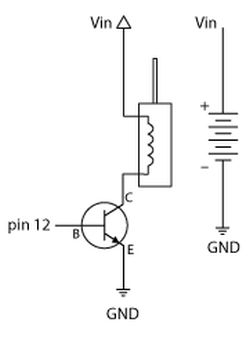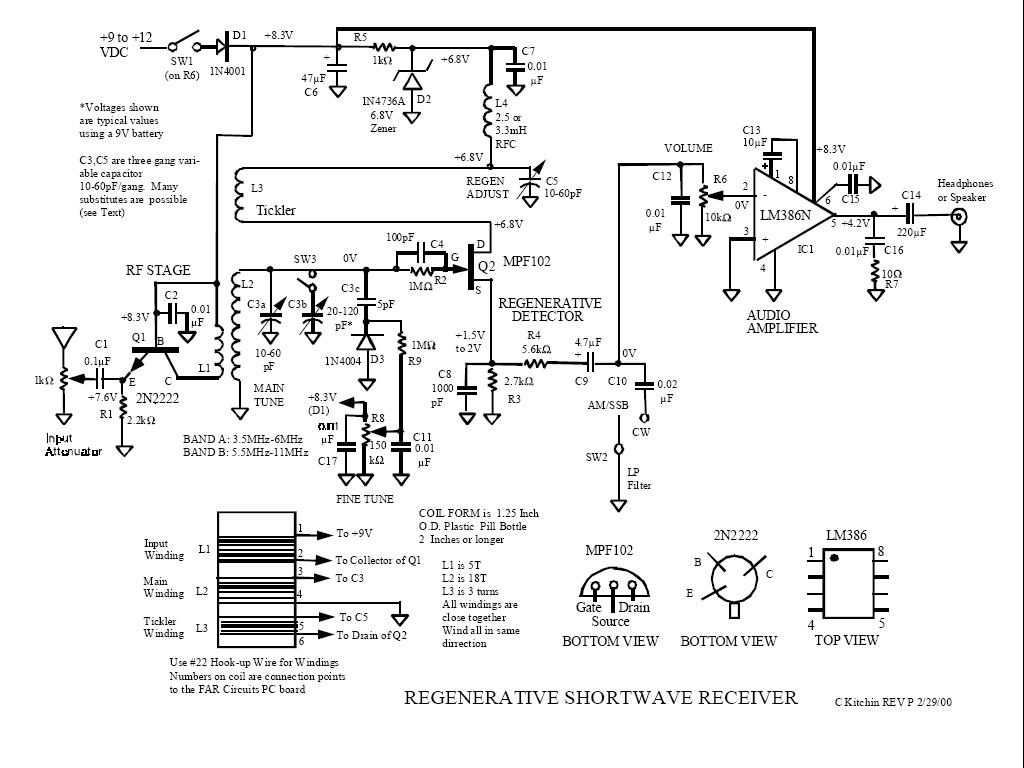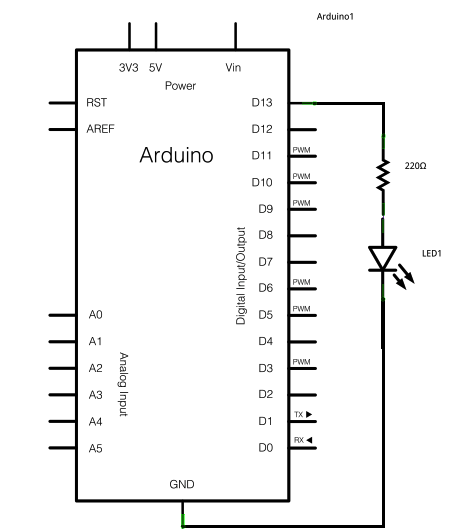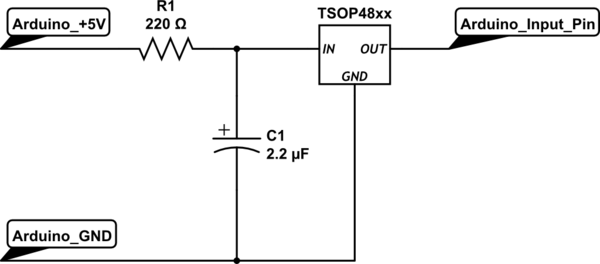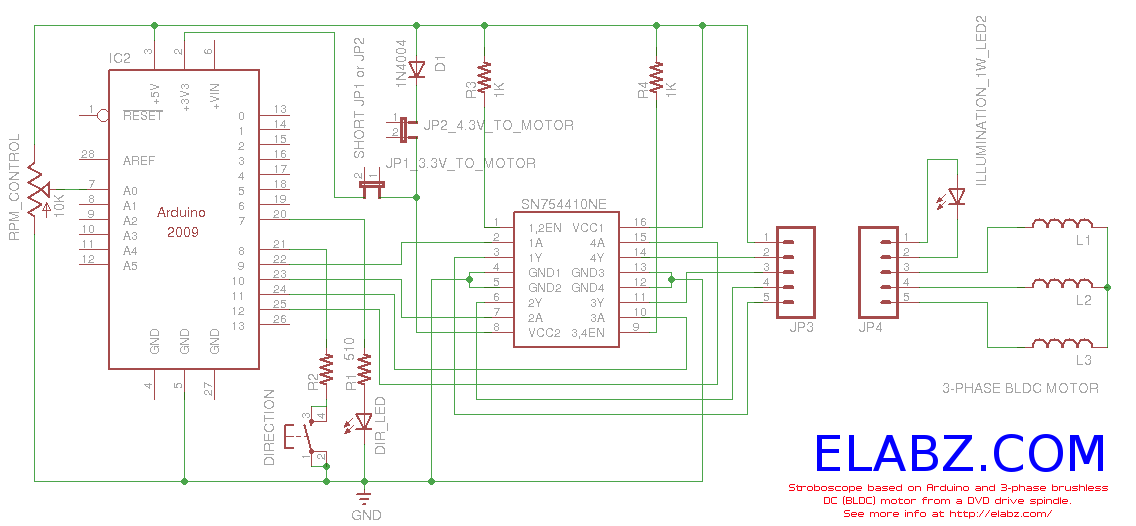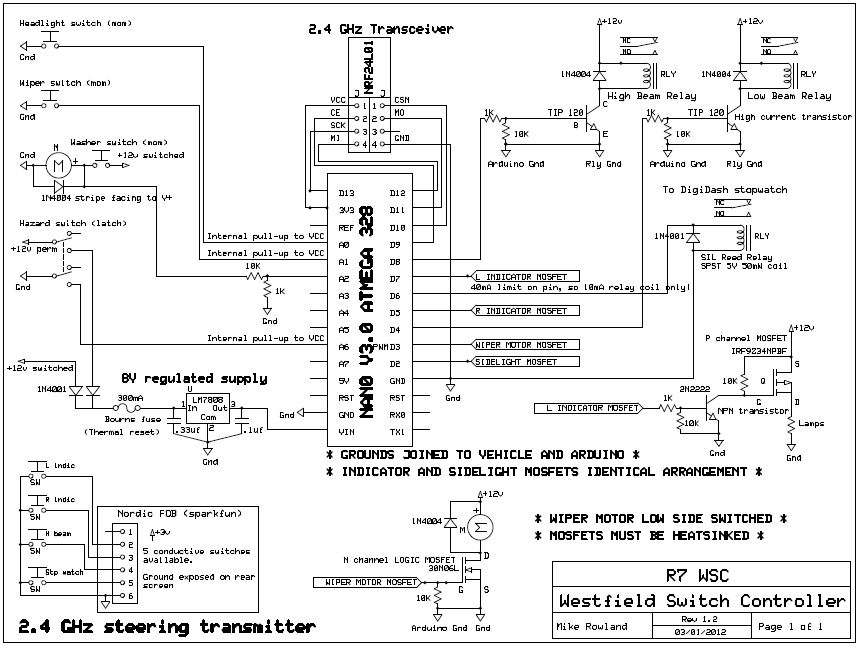
Arduino Projects
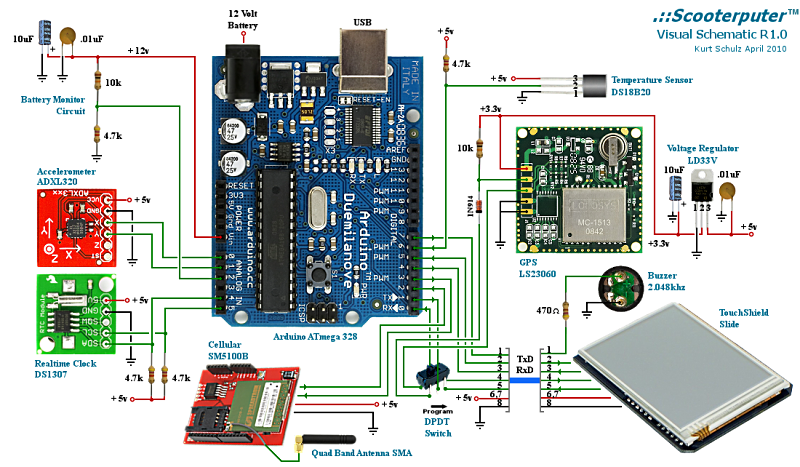
Powerful for its size and cost, and extremely easy to learn and use. A voltage monitor was added to a scooter to warn when the battery might need recharging, instead of waiting for the electric starter to fail. An Arduino Duemilanove was used to create a simple programmable voltage divider with three LEDs indicating battery status: low, good, and charging. The project expanded with the addition of Liquidware's TouchShield Slide OLED display with touchscreen, which also included temperature and time/date readouts. A DS18B20 temperature sensor and a DS1307 RTC chip were sourced from Sparkfun. The TouchShield display is separated from the Duemilanove, cell module, and sensor shields, which are installed under the scooter's hood, providing power and signals to the display via a standard 8-wire Ethernet cable. This allows the sensors (accelerometer, GPS, cell module, etc.) to remain functional even without the removable external display. The sensors are mounted on a Proto Shield PCB from Adafruit Industries. Wiring was primarily done using 30 gauge Kynar solid wire, with heavier gauge used for power and ground connections to ensure good mechanical connections against shock and vibrations. Breakout boards for surface mount chips were used for ease of soldering and construction time. The DS1307 RTC chip is utilized for storing trip meter and odometer values in its non-volatile RAM, despite GPS data being available for time and date. The GPS communicates with the Duemilanove via pins 0 and 1 for TxD and RxD signals, while the TouchShield Slide uses pins 2 and 3 during normal operation. A program switch disconnects the TouchShield from these pins when not downloading sketches. The GPS operates at 9600 baud using the hardware serial port, while the TouchShield Slide (19200 baud) and Cell Module (4800 baud) utilize digital I/O pins with Mikal Hart's NewSoftSerial library for software interrupt-driven serial communications. The GPS chip is powered by a 3.3V regulator, with a 10k resistor and 1N914 diode circuit on the serial RxD line to dampen the 5V signal from the Arduino hardware TxD line.
The described electronic schematic involves a compact and versatile system designed for monitoring battery status and environmental conditions on a scooter. The core of the system is based on the Arduino Duemilanove microcontroller, which serves as the central processing unit for managing various sensors and modules. The voltage monitoring is achieved through a programmable voltage divider, which allows the user to receive real-time feedback on the battery status through three distinct LEDs.
The integration of the TouchShield Slide OLED display enhances user interaction by providing a graphical interface for displaying battery status, temperature readings, and the current time and date. The use of a DS18B20 temperature sensor allows for precise temperature measurement, while the DS1307 Real-Time Clock (RTC) chip ensures that time-related data is accurately maintained, even during power interruptions, thanks to its non-volatile RAM.
Communication between the components is facilitated through a combination of hardware serial and software serial protocols, allowing for efficient data transfer. The GPS module, which provides location data, operates at 9600 baud and connects directly to the hardware serial pins of the Arduino. The TouchShield Slide and the cell module utilize digital I/O pins for communication, employing the NewSoftSerial library to handle multiple serial devices simultaneously.
Power management is also a critical aspect of the design, with a dedicated 3.3V regulator supplying the GPS module. The implementation of breakout boards for surface mount devices simplifies the assembly process, ensuring reliable connections that can withstand the physical stresses encountered during scooter operation. Overall, this system exemplifies a well-thought-out electronic design that combines functionality, user engagement, and robustness, making it ideal for mobile applications.Powerful for its size and cost, and extemely easy to learn and use. I spend a fair amount of time zipping around townon my scooter, and thought it would be cool to add a voltage monitor to warn when the battery might need recharging. Waiting until the electric starter no longer works is somehow lacking. So after an evening with an Arduino Duemilanove, I had a simple programmable voltage divider with 3 LEDs indicating battery low, good, and charging. Done. That`s when I saw Liquidware`s very cool TouchShield Slide OLED display with touch screen. It was telling me it wanted to be on my scooter. It`s a bit overkill for just battery status, so I added temperature and time/date readouts. I went to Sparkfun and found a DS18B20 temperature sensor and a DS1307 RTC chip. Perfect. Oh wait, what`s this. an accelerometer Sweet! Hey, a GPS chip. You can see in the first photo that the TouchShield display is separated from the Duemilanove / Cell Module / Sensor shields. These are installed "under the hood" of my scooter and provide power and signals to the display module via a standard 8-wire ethernet cable.
This keeps the sensors (accelerometer, GPS, cell module, etc. ) with the scooter making it functional even without the removable external display, as we`ll see later. (NOTE: this photo was taken before the display was fully mounted inside the enclosure, and is shown without the protective rubber boot.
) The sensors are mounted on a Proto Shield PCB from Ladyada`s Adafruit Industries (which is also where I get my Duemilanoves). Most of the wiring was done using 30 gauge Kynar solid wire, with heavier gauge used for some power and ground connections.
Good mechanical connections are important considering the shock and vibrations this will be subjected to. I went with breakout boards for the surface mount chips. They take up a bit more real estate on the PCB but are very easy to solder and save a lot of construction time.
Note the DS1307 RTC on the underside. the profile is still low enough to allow the parts to fit nicely in the open space between boards when stacked. I soldered a right-angle pin header directly to the pads of the GPS breakout board, and straight pin headers on the others.
You might be wondering why I even included the RTC chip since time-of-day and date can be gotten from the GPS data. The DS1307 RTC chip also has 56 bytes of non-volatile RAM. I`m using these registers for storing the trip meter and odometer values so they can be restored between power cycles.
The GPS uses pins 0 and 1 for its TxD and RxD signals to communicate to the Duemilanove. The TouchShield Slide also uses these pins for downloading sketches. The "Program Switch" is used to disconnect the TouchShield Slide from these pins when not downloading so they`re free for use by the GPS. Fortunately the TouchShield Slide uses pins 2 and 3 during normal operation, which I`m driving with digital I/O pins 4 and 5 on the Duemilanove.
Three devices require serial communications (GPS, TouchShield Slide, and Cell Module), and it was a real challenge getting the Duemilanove to support these at data rates needed for the desired performance. Having the GPS, running at 9600 baud, use the hardware serial port (pins 0 and 1) proved to be the best approach.
The TouchShield Slide (19200 baud) and Cell Module (4800 baud) use digital I/O pins, and Mikal Hart`s NewSoftSerial library for `software` interrupt driven serial communications was invaluable in getting these to play nicely together. The GPS chip is powered by the 3. 3v regulator. The 10k resistor and 1N914 diode circuit on the serial RxD line of the chip are used to dampen the 5v signal from the Arduino hardware TxD line u
🔗 External reference
The described electronic schematic involves a compact and versatile system designed for monitoring battery status and environmental conditions on a scooter. The core of the system is based on the Arduino Duemilanove microcontroller, which serves as the central processing unit for managing various sensors and modules. The voltage monitoring is achieved through a programmable voltage divider, which allows the user to receive real-time feedback on the battery status through three distinct LEDs.
The integration of the TouchShield Slide OLED display enhances user interaction by providing a graphical interface for displaying battery status, temperature readings, and the current time and date. The use of a DS18B20 temperature sensor allows for precise temperature measurement, while the DS1307 Real-Time Clock (RTC) chip ensures that time-related data is accurately maintained, even during power interruptions, thanks to its non-volatile RAM.
Communication between the components is facilitated through a combination of hardware serial and software serial protocols, allowing for efficient data transfer. The GPS module, which provides location data, operates at 9600 baud and connects directly to the hardware serial pins of the Arduino. The TouchShield Slide and the cell module utilize digital I/O pins for communication, employing the NewSoftSerial library to handle multiple serial devices simultaneously.
Power management is also a critical aspect of the design, with a dedicated 3.3V regulator supplying the GPS module. The implementation of breakout boards for surface mount devices simplifies the assembly process, ensuring reliable connections that can withstand the physical stresses encountered during scooter operation. Overall, this system exemplifies a well-thought-out electronic design that combines functionality, user engagement, and robustness, making it ideal for mobile applications.Powerful for its size and cost, and extemely easy to learn and use. I spend a fair amount of time zipping around townon my scooter, and thought it would be cool to add a voltage monitor to warn when the battery might need recharging. Waiting until the electric starter no longer works is somehow lacking. So after an evening with an Arduino Duemilanove, I had a simple programmable voltage divider with 3 LEDs indicating battery low, good, and charging. Done. That`s when I saw Liquidware`s very cool TouchShield Slide OLED display with touch screen. It was telling me it wanted to be on my scooter. It`s a bit overkill for just battery status, so I added temperature and time/date readouts. I went to Sparkfun and found a DS18B20 temperature sensor and a DS1307 RTC chip. Perfect. Oh wait, what`s this. an accelerometer Sweet! Hey, a GPS chip. You can see in the first photo that the TouchShield display is separated from the Duemilanove / Cell Module / Sensor shields. These are installed "under the hood" of my scooter and provide power and signals to the display module via a standard 8-wire ethernet cable.
This keeps the sensors (accelerometer, GPS, cell module, etc. ) with the scooter making it functional even without the removable external display, as we`ll see later. (NOTE: this photo was taken before the display was fully mounted inside the enclosure, and is shown without the protective rubber boot.
) The sensors are mounted on a Proto Shield PCB from Ladyada`s Adafruit Industries (which is also where I get my Duemilanoves). Most of the wiring was done using 30 gauge Kynar solid wire, with heavier gauge used for some power and ground connections.
Good mechanical connections are important considering the shock and vibrations this will be subjected to. I went with breakout boards for the surface mount chips. They take up a bit more real estate on the PCB but are very easy to solder and save a lot of construction time.
Note the DS1307 RTC on the underside. the profile is still low enough to allow the parts to fit nicely in the open space between boards when stacked. I soldered a right-angle pin header directly to the pads of the GPS breakout board, and straight pin headers on the others.
You might be wondering why I even included the RTC chip since time-of-day and date can be gotten from the GPS data. The DS1307 RTC chip also has 56 bytes of non-volatile RAM. I`m using these registers for storing the trip meter and odometer values so they can be restored between power cycles.
The GPS uses pins 0 and 1 for its TxD and RxD signals to communicate to the Duemilanove. The TouchShield Slide also uses these pins for downloading sketches. The "Program Switch" is used to disconnect the TouchShield Slide from these pins when not downloading so they`re free for use by the GPS. Fortunately the TouchShield Slide uses pins 2 and 3 during normal operation, which I`m driving with digital I/O pins 4 and 5 on the Duemilanove.
Three devices require serial communications (GPS, TouchShield Slide, and Cell Module), and it was a real challenge getting the Duemilanove to support these at data rates needed for the desired performance. Having the GPS, running at 9600 baud, use the hardware serial port (pins 0 and 1) proved to be the best approach.
The TouchShield Slide (19200 baud) and Cell Module (4800 baud) use digital I/O pins, and Mikal Hart`s NewSoftSerial library for `software` interrupt driven serial communications was invaluable in getting these to play nicely together. The GPS chip is powered by the 3. 3v regulator. The 10k resistor and 1N914 diode circuit on the serial RxD line of the chip are used to dampen the 5v signal from the Arduino hardware TxD line u
🔗 External reference
